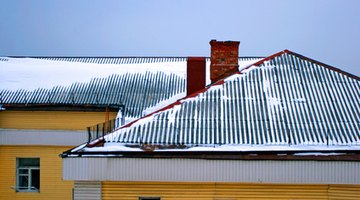How to Calculate Square Feet of a Roof
Before you do any roofing work, you must calculate the roof’s square footage to determine how much material you need. Shingles and other roofing materials, such as underlayment, are typically measured in squares that are 10 feet long and 10 feet wide, with each square measuring 100 square feet.

When calculating square footage for your roof, always add at least 10 percent of the total to account for waste.
-
Measure the length and width of every roof plane or surface. Include dormers (the small “outjuttings” over attic windows). This information may be available on the home’s original building plan or, if the roof surface is relatively low and flat, you can measure it yourself. If you cannot get up to the roof and measure safely, either hire a professional or make your best estimate of the roof surface dimensions.
-
Multiply the length and width of each square or rectangle-shaped plane. Calculate each plane separately. For example, if one roof plane measures 120 feet by 120 feet, 120 x 120 = 14,400 square feet.
-
Calculate the square footage for symmetrical, triangle-shaped planes by multiplying the length of the triangle's base (longest side) by its height (the distance from the middle of the longest side to the opposite corner). Then divide the total by 2 to get the square footage. For example, if a triangle-shaped roof plane measures 60 feet along the base and is 30 feet high, we have 60 x 30 = 1,800 feet, divided by 2 = 900 square feet for the triangle-shaped plane.
-
Divide any irregularly shaped areas of the roof into more manageable triangles and rectangles, then calculate square footage for those individual elements and add them to get the total square footage. For example, take an area made up of a triangle that's 20 feet high and has a base of 40 feet, plus a square that's 40 feet by 40 feet. The square footage would be 40 x 40 = 1,600 square feet (the square) plus 20 x 40 = 800 / 2 = 400 square feet (the triangle). And 1,600 + 400 = 2,000 square feet total.
-
Add the square footage for all the planes together. The result is the total square footage of your roof. If For example, the total square footage for the examples used so far would be 14,400 (the rectangular plane) plus 900 (the triangle) plus 2,000 (the irregular shape) = 17,300 square feet.
-
Multiply the square footage of your roof by .1 to get the 10 percent waste allowance. To conclude the example, if your total roofing area is 17,300 square feet, your waste allowance would be 17,300 x .1 = 1,730 square feet. The total amount of roofing material you need is 17,300 + 1,730 = 19,030 square feet.
The Drip Cap
- Before you do any roofing work, you must calculate the roof’s square footage to determine how much material you need.
- Calculate each plane separately.
- For example, if a triangle-shaped roof plane measures 60 feet along the base and is 30 feet high, we have 60 x 30 = 1,800 feet, divided by 2 = 900 square feet for the triangle-shaped plane.
- The square footage would be 40 x 40 = 1,600 square feet (the square) plus 20 x 40 = 800 / 2 = 400 square feet (the triangle).
References
Writer Bio
Lisa Maloney is a travel and outdoors writer based in Anchorage, Alaska. She's written four outdoors and travel guidebooks, including the award-winning "Moon Alaska," and regularly contributes to local and national publications. She also has a background in personal training, with more than 6,000 hours of hands-on experience.
Photo Credits
- roof image by sanyal from Fotolia.com
- roof image by sanyal from Fotolia.com
More Articles



